英语教学案例分析
英语教学案例分析【优秀14篇】
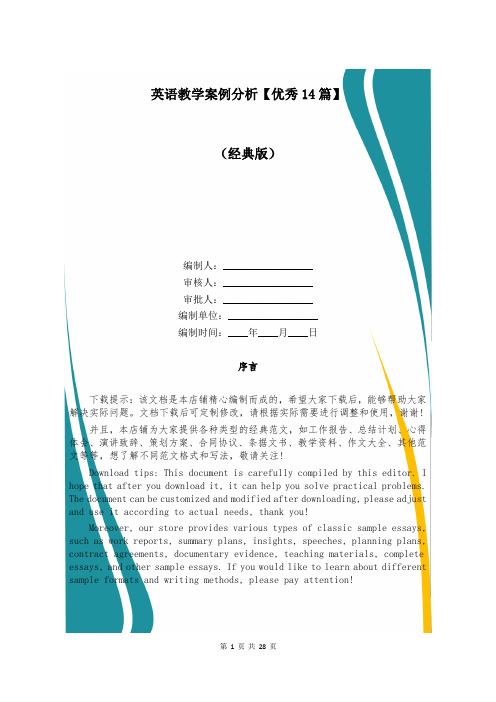
英语教学案例分析【优秀14篇】(经典版)编制人:__________________审核人:__________________审批人:__________________编制单位:__________________编制时间:____年____月____日序言下载提示:该文档是本店铺精心编制而成的,希望大家下载后,能够帮助大家解决实际问题。
文档下载后可定制修改,请根据实际需要进行调整和使用,谢谢!并且,本店铺为大家提供各种类型的经典范文,如工作报告、总结计划、心得体会、演讲致辞、策划方案、合同协议、条据文书、教学资料、作文大全、其他范文等等,想了解不同范文格式和写法,敬请关注!Download tips: This document is carefully compiled by this editor. I hope that after you download it, it can help you solve practical problems. The document can be customized and modified after downloading, please adjust and use it according to actual needs, thank you!Moreover, our store provides various types of classic sample essays, such as work reports, summary plans, insights, speeches, planning plans, contract agreements, documentary evidence, teaching materials, complete essays, and other sample essays. If you would like to learn about different sample formats and writing methods, please pay attention!英语教学案例分析【优秀14篇】小学英语教学案例篇一在一次英语课上,我在教“Look at me ,this is my head, this is my ear…”时,由于录音中语速太快,学生跟不上来,我便放慢语速,并且用纯正的美式英语让学生跟读,但几遍下来,有些同学的语速还是有些绕可是来,便产生了畏惧情绪、不愿再读了,当我再次让他们模仿跟读时,有位同学竟然干脆说:“我是读不来的。
中学英语教学实践案例(3篇)

第1篇一、案例背景随着我国教育改革的不断深入,中学英语教学面临着新的挑战。
为了提高学生的英语水平,培养具有国际视野的人才,教师需要不断探索新的教学方法。
本文以某中学英语教师在实际教学中的一节课为例,探讨如何运用任务型教学法提高学生的英语听说能力。
二、案例描述1. 教学目标(1)知识目标:掌握有关旅游的词汇和短语,了解不同国家的旅游文化。
(2)技能目标:提高学生的听说能力,培养学生的合作意识。
(3)情感目标:激发学生对旅游的兴趣,培养学生的跨文化交际意识。
2. 教学内容(1)词汇:travel, tourist, culture, scenery, famous, etc.(2)短语:go on a trip, visit a place, enjoy the scenery, etc.(3)句型:What do you like to do during your vacation? I like to visit famous places. I enjoy the scenery very much.3. 教学过程(1)导入教师播放一段关于旅游的英文视频,引导学生观察并思考:What is the video about? What do you see in the video? 学生回答后,教师总结:The video is about traveling. There are many beautiful places in the world.(2)新课导入教师展示一张世界地图,引导学生谈论自己想去哪些国家旅游。
学生自由发言,教师根据学生的回答板书相关的国家名称和旅游景点。
(3)任务一:词汇学习教师带领学生学习新课词汇,并让学生用新学的词汇造句。
例如:I like to visit the Great Wall in China. I enjoy the scenery of the Yellow Mountains.(4)任务二:听说练习教师将学生分成四人一组,每组选择一个国家作为旅游目的地。
小学英语教育教学案例分析【3篇】
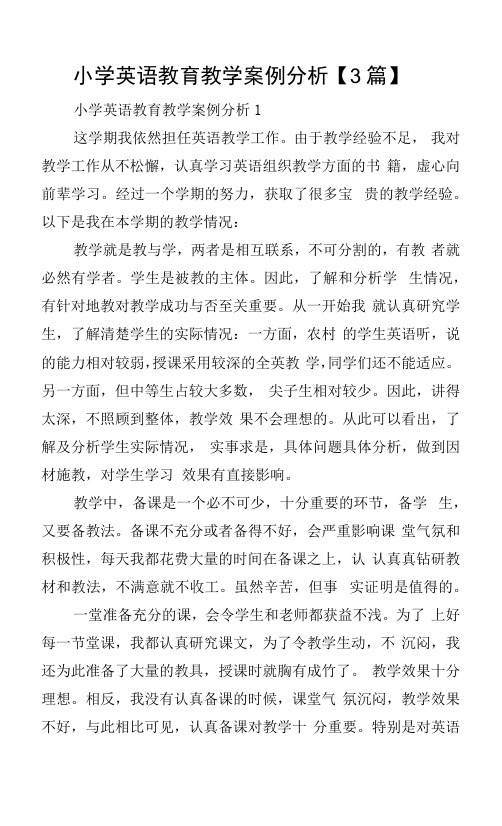
小学英语教育教学案例分析【3篇】小学英语教育教学案例分析1这学期我依然担任英语教学工作。
由于教学经验不足,我对教学工作从不松懈,认真学习英语组织教学方面的书籍,虚心向前辈学习。
经过一个学期的努力,获取了很多宝贵的教学经验。
以下是我在本学期的教学情况:教学就是教与学,两者是相互联系,不可分割的,有教者就必然有学者。
学生是被教的主体。
因此,了解和分析学生情况,有针对地教对教学成功与否至关重要。
从一开始我就认真研究学生,了解清楚学生的实际情况:一方面,农村的学生英语听,说的能力相对较弱,授课采用较深的全英教学,同学们还不能适应。
另一方面,但中等生占较大多数,尖子生相对较少。
因此,讲得太深,不照顾到整体,教学效果不会理想的。
从此可以看出,了解及分析学生实际情况,实事求是,具体问题具体分析,做到因材施教,对学生学习效果有直接影响。
教学中,备课是一个必不可少,十分重要的环节,备学生,又要备教法。
备课不充分或者备得不好,会严重影响课堂气氛和积极性,每天我都花费大量的时间在备课之上,认认真真钻研教材和教法,不满意就不收工。
虽然辛苦,但事实证明是值得的。
一堂准备充分的课,会令学生和老师都获益不浅。
为了上好每一节堂课,我都认真研究课文,为了令教学生动,不沉闷,我还为此准备了大量的教具,授课时就胸有成竹了。
教学效果十分理想。
相反,我没有认真备课的时候,课堂气氛沉闷,教学效果不好,与此相比可见,认真备课对教学十分重要。
特别是对英语这门学生不甚熟悉并感到困难的外语来说至关重要。
备课充分,能调动学生的积极性,上课效果就好。
但同时又要有驾驭课堂的能力,因为学生在课堂上的一举一动都会直接影响课堂教学。
上课内容丰富,现实。
教态自然,讲课生动,难易适中照顾全部,就自然能够吸引住学生。
所以,老师每天都要有充足的精神,让学生感受到一种自然气氛。
这样,授课就事半功倍。
回看自己的授课,我感到有点愧疚,因为有时我并不能很好地做到这点。
当学生在课堂上无心向学,违反纪律时,我的情绪就受到影响,并且把这带到教学中,让原本正常的讲课受到冲击,发挥不到应有的水平,以致影响教学效果。
英语教学案例分析范文6篇初中

英语教学案例分析范文6篇初中Effective English teaching in middle school is crucial for laying a strong foundation for students' language proficiency and future academic success. In this essay, we will examine six case studies that illustrate various approaches and strategies employed by skilled English teachers to engage and support their middle school students.Case Study 1: Integrating Technology to Enhance Engagement Mrs. Johnson, an experienced English teacher at a suburban middle school, recognized the importance of incorporating technology to captivate her students' attention and foster active learning. She began by introducing interactive whiteboard activities, where students could manipulate words, sentences, and grammatical structures on the board, enhancing their understanding of language concepts. Additionally, Mrs. Johnson utilized online educational platforms that provided personalized practice exercises and immediate feedback, allowing students to take ownership of their learning and progress at their own pace.The integration of technology not only increased studentengagement but also enabled Mrs. Johnson to differentiate instruction and cater to diverse learning styles. Students who struggled with traditional pen-and-paper exercises found the digital activities more appealing and accessible, while those who thrived on independent learning benefited from the self-paced nature of the online resources. The result was a more dynamic and inclusive classroom environment, where all students felt empowered to participate and succeed in their English studies.Case Study 2: Fostering Critical Thinking through Literature Circles Mr. Patel, a middle school English teacher in a diverse urban setting, recognized the importance of developing his students' critical thinking skills. He implemented a literature circles approach, where students were divided into small groups and assigned different roles, such as discussion leader, connector, and literary analyst. Each group was responsible for reading a selected work of literature and engaging in collaborative discussions to unpack the themes, characters, and literary devices.The literature circles not only encouraged active engagement with the text but also cultivated essential communication and problem-solving skills. Students learned to listen actively, express their ideas clearly, and consider multiple perspectives. Mr. Patel's role shifted from a traditional lecturer to a facilitator, guiding the discussions and prompting students to delve deeper into the literary analysis.The success of this approach was evident in the students' increased confidence in expressing their interpretations and the depth of their literary analysis. Additionally, the collaborative nature of the literature circles fostered a sense of community and camaraderie among the students, further enhancing their overall learning experience.Case Study 3: Integrating Authentic Cultural ExperiencesIn a middle school with a growing population of English language learners, Ms. Garcia recognized the importance of incorporating authentic cultural experiences into her English lessons. She collaborated with the school's diversity committee to organize cultural celebrations and invite guest speakers from various backgrounds to share their stories and traditions.During these events, students had the opportunity to engage with the English language in a meaningful and contextual manner. They learned vocabulary and expressions related to the featured cultures, participated in interactive activities, and gained a deeper appreciation for the diversity within their school community. The cultural experiences also served as a platform for students to practice their speaking and listening skills in a low-stress, authentic setting.The integration of authentic cultural experiences not only improvedthe English language proficiency of the English language learners but also fostered a greater sense of inclusion and understanding among all students. The cross-cultural exchange and exposure to diverse perspectives enriched the learning environment and contributed to the overall growth and development of the students.Case Study 4: Differentiated Instruction for Struggling Readers Mrs. Nguyen, a middle school English teacher in a high-needs district, recognized the diverse learning needs of her students, particularly those who struggled with reading comprehension. She implemented a multi-tiered system of support, where she provided targeted interventions and differentiated instruction to address the individual needs of her students.For students who required additional support, Mrs. Nguyen utilized research-based reading strategies, such as guided reading, vocabulary development, and explicit instruction in phonics and fluency. She also incorporated the use of audiobooks, text-to-speech software, and graphic organizers to help struggling readers access the content and actively engage with the material.Mrs. Nguyen's dedication to differentiated instruction paid off, as her struggling readers demonstrated significant improvements in their reading abilities and overall academic performance. The individualized attention and tailored support not only boosted theirconfidence but also instilled a love for reading and learning.Case Study 5: Integrating Project-Based LearningMr. Goldstein, a middle school English teacher in a suburban setting, recognized the importance of making the English curriculum more relevant and engaging for his students. He implemented a project-based learning approach, where students were tasked with creating multimedia presentations on topics of their choice, ranging from social issues to literary analyses.The project-based learning approach allowed students to take an active role in their learning, as they conducted research, synthesized information, and utilized various technological tools to present their findings. Mr. Goldstein provided guidance and feedback throughout the process, ensuring that students developed essential skills, such as critical thinking, problem-solving, and effective communication.The project-based learning activities not only enhanced the students' engagement and motivation but also fostered their ability to collaborate, think creatively, and apply their knowledge to real-world situations. The final presentations showcased the students' diverse talents and perspectives, further enriching the learning environment.Case Study 6: Integrating Interdisciplinary ConnectionsMs. Lim, a middle school English teacher in a STEM-focused school,recognized the importance of integrating interdisciplinary connections to make the English curriculum more relevant and meaningful for her students. She collaborated with her colleagues from the science, mathematics, and social studies departments to develop cross-curricular lessons and projects.For example, in a unit on persuasive writing, Ms. Lim worked with the science teacher to have students research and write persuasive essays on environmental issues. The students not only honed their English language skills but also deepened their understanding of scientific concepts and their real-world applications. Similarly, in a poetry unit, Ms. Lim partnered with the art teacher to have students create visual representations of their poems, fostering their creativity and artistic expression.The integration of interdisciplinary connections not only enhanced the relevance and depth of the English curriculum but also encouraged students to see the interconnectedness of different subject areas. This approach helped students develop a more holistic understanding of the world around them and the role of language in various disciplines.In conclusion, the six case studies presented in this essay demonstrate the diverse and effective strategies employed by skilled English teachers in middle school settings. From integratingtechnology to fostering critical thinking, incorporating authentic cultural experiences, differentiating instruction, implementing project-based learning, and making interdisciplinary connections, these teachers have created dynamic and inclusive learning environments that support the academic and personal growth of their students. The success of these approaches underscores the importance of continuous professional development, collaboration, and a student-centered approach to English language instruction in middle schools.。
小学英语教学10个案例分析
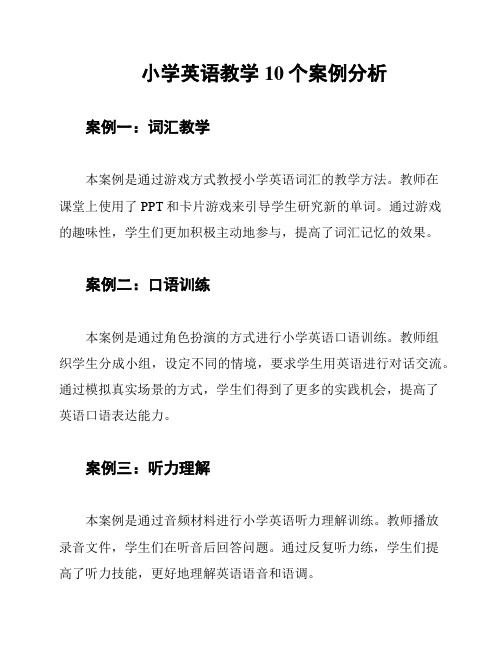
小学英语教学10个案例分析案例一:词汇教学本案例是通过游戏方式教授小学英语词汇的教学方法。
教师在课堂上使用了PPT和卡片游戏来引导学生研究新的单词。
通过游戏的趣味性,学生们更加积极主动地参与,提高了词汇记忆的效果。
案例二:口语训练本案例是通过角色扮演的方式进行小学英语口语训练。
教师组织学生分成小组,设定不同的情境,要求学生用英语进行对话交流。
通过模拟真实场景的方式,学生们得到了更多的实践机会,提高了英语口语表达能力。
案例三:听力理解本案例是通过音频材料进行小学英语听力理解训练。
教师播放录音文件,学生们在听音后回答问题。
通过反复听力练,学生们提高了听力技能,更好地理解英语语音和语调。
案例四:阅读训练本案例是通过阅读故事书进行小学英语阅读训练。
教师为学生选择适合水平的英文故事书,并引导学生阅读并理解故事内容。
通过阅读训练,学生们提升了阅读理解能力,扩大了词汇量。
案例五:写作指导本案例是通过写作指导提高小学英语写作能力。
教师引导学生写作英语日记,给予实时反馈和指导。
通过写作指导,学生们掌握了写作技巧,提高了英语写作水平。
案例六:语法讲解本案例是通过语法讲解提高小学英语语法掌握程度。
教师通过示意图和例句帮助学生理解英语语法规则。
通过语法讲解,学生们更好地掌握了英语语法知识,提高了语法运用能力。
案例七:互动研究本案例是通过互动研究提升小学英语综合能力。
教师组织学生进行小组活动、角色扮演等互动形式的研究。
通过互动研究,学生们锻炼了团队合作能力,增强了对英语的综合应用能力。
案例八:研究资源利用本案例是通过研究资源利用提升小学英语研究效果。
教师引导学生使用英语研究网站、研究软件等研究资源,提供丰富多样的研究材料。
通过充分利用研究资源,学生们主动探索研究,提高了研究效果。
案例九:评价与反馈本案例是通过评价与反馈帮助学生提高小学英语研究。
教师定期对学生进行英语研究成果评估,并及时给予反馈。
通过评价与反馈,学生们了解自己的研究进步,并针对性地进行调整和提升。
小学英语教学案例分析(共5篇)
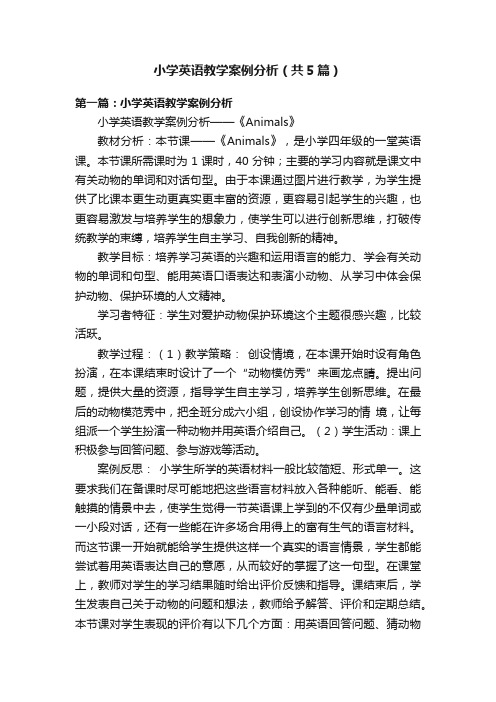
小学英语教学案例分析(共5篇)第一篇:小学英语教学案例分析小学英语教学案例分析——《Animals》教材分析:本节课——《Animals》,是小学四年级的一堂英语课。
本节课所需课时为 1 课时,40 分钟;主要的学习内容就是课文中有关动物的单词和对话句型。
由于本课通过图片进行教学,为学生提供了比课本更生动更真实更丰富的资源,更容易引起学生的兴趣,也更容易激发与培养学生的想象力,使学生可以进行创新思维,打破传统教学的束缚,培养学生自主学习、自我创新的精神。
教学目标:培养学习英语的兴趣和运用语言的能力、学会有关动物的单词和句型、能用英语口语表达和表演小动物、从学习中体会保护动物、保护环境的人文精神。
学习者特征:学生对爱护动物保护环境这个主题很感兴趣,比较活跃。
教学过程:(1)教学策略:创设情境,在本课开始时设有角色扮演,在本课结束时设计了一个“动物模仿秀”来画龙点睛。
提出问题,提供大量的资源,指导学生自主学习,培养学生创新思维。
在最后的动物模范秀中,把全班分成六小组,创设协作学习的情境,让每组派一个学生扮演一种动物并用英语介绍自己。
(2)学生活动:课上积极参与回答问题、参与游戏等活动。
案例反思:小学生所学的英语材料一般比较简短、形式单一。
这要求我们在备课时尽可能地把这些语言材料放入各种能听、能看、能触摸的情景中去,使学生觉得一节英语课上学到的不仅有少量单词或一小段对话,还有一些能在许多场合用得上的富有生气的语言材料。
而这节课一开始就能给学生提供这样一个真实的语言情景,学生都能尝试着用英语表达自己的意愿,从而较好的掌握了这一句型。
在课堂上,教师对学生的学习结果随时给出评价反馈和指导。
课结束后,学生发表自己关于动物的问题和想法,教师给予解答、评价和定期总结。
本节课对学生表现的评价有以下几个方面:用英语回答问题、猜动物的英文名、上网找动物资料、制作电子贺卡、发送电子邮件、网上讨论区中发表的观点、与他人合作扮演某一种动物,表演时用英语对话.Internet 学习环境在英语口语教学中的应用的教学模式由六部分组成:眼观情境,自我练说,耳听他说,协作合说,互相评说、迁移练说。
高中英语教师教学案例分析范文6篇
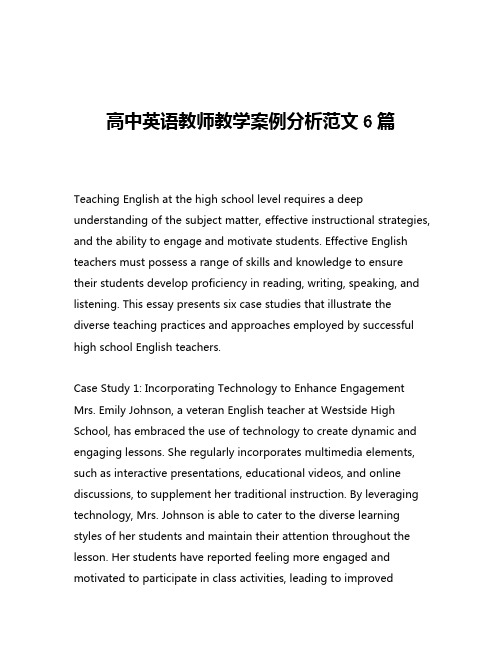
高中英语教师教学案例分析范文6篇Teaching English at the high school level requires a deep understanding of the subject matter, effective instructional strategies, and the ability to engage and motivate students. Effective English teachers must possess a range of skills and knowledge to ensure their students develop proficiency in reading, writing, speaking, and listening. This essay presents six case studies that illustrate the diverse teaching practices and approaches employed by successful high school English teachers.Case Study 1: Incorporating Technology to Enhance Engagement Mrs. Emily Johnson, a veteran English teacher at Westside High School, has embraced the use of technology to create dynamic and engaging lessons. She regularly incorporates multimedia elements, such as interactive presentations, educational videos, and online discussions, to supplement her traditional instruction. By leveraging technology, Mrs. Johnson is able to cater to the diverse learning styles of her students and maintain their attention throughout the lesson. Her students have reported feeling more engaged and motivated to participate in class activities, leading to improvedcomprehension and academic performance.Case Study 2: Differentiated Instruction for Diverse LearnersMr. Liam Patel, an English teacher at Eastwood High School, recognizes the importance of addressing the unique needs and abilities of each student in his classroom. He employs a range of differentiated instructional strategies to ensure that all of his students, regardless of their academic level or learning preferences, have the opportunity to succeed. This includes offering tiered assignments, providing scaffolding for struggling learners, and incorporating project-based learning to allow students to demonstrate their understanding in various ways. By tailoring his instruction to the individual needs of his students, Mr. Patel has seen a significant improvement in their overall academic achievement and engagement.Case Study 3: Fostering Critical Thinking through Socratic Seminars Ms. Olivia Hernandez, an English teacher at Northside High School, is a strong proponent of the Socratic seminar approach. She regularly facilitates discussions in which students engage in deep, thoughtful dialogue about complex literary texts, challenging them to analyze, interpret, and defend their ideas. By encouraging students to question, explore, and critically examine the material, Ms. Hernandez helps them develop essential critical thinking and communication skills. Her students have reported feeling more confident in theirability to express their ideas and engage in meaningful intellectual discourse.Case Study 4: Integrating Interdisciplinary ConnectionsMr. Ethan Nguyen, an English teacher at Southside High School, recognizes the importance of helping his students make connections between the English curriculum and other academic disciplines. He regularly collaborates with teachers from other departments to design interdisciplinary units and projects that allow students to apply their English skills in a broader context. For example, he has worked with the history department to create a unit on the literature and social movements of the Civil Rights era, and with the science department to explore the intersection of literature and environmental science. By fostering these interdisciplinary connections, Mr. Nguyen helps his students develop a more holistic understanding of the subject matter and its real-world applications.Case Study 5: Emphasis on Writing DevelopmentMs. Sophia Ramirez, an English teacher at Westwood High School, places a strong emphasis on the development of her students' writing skills. She has implemented a comprehensive writing program that includes frequent opportunities for students to engage in various types of writing, from personal narratives to research-based essays. Ms. Ramirez provides detailed feedback and individualized instruction to help her students improve their writingmechanics, organization, and overall effectiveness. Her students have reported feeling more confident in their writing abilities and better prepared for the rigors of college-level work.Case Study 6: Cultivating a Love for LiteratureMr. Aiden Chen, an English teacher at Eastside High School, is passionate about fostering a love for literature in his students. He curates a diverse range of literary texts, from classic novels to contemporary poetry, and creates engaging lessons that encourage students to explore the themes, characters, and literary devices within these works. Mr. Chen also incorporates opportunities for students to engage in creative writing and book discussions, allowing them to express their personal interpretations and connections to the material. By cultivating a genuine appreciation for literature, Mr. Chen has seen his students develop a deeper understanding and enjoyment of the English language and its power to convey human experiences.These six case studies highlight the diverse teaching practices and approaches employed by successful high school English teachers. From incorporating technology to fostering critical thinking, these educators have demonstrated their commitment to providing their students with a well-rounded and enriching educational experience. By drawing upon these examples, other English teachers can gain valuable insights and inspiration to enhance their own instructionalpractices and better support the academic and personal growth of their students.。
英语教学案例分析最新7篇
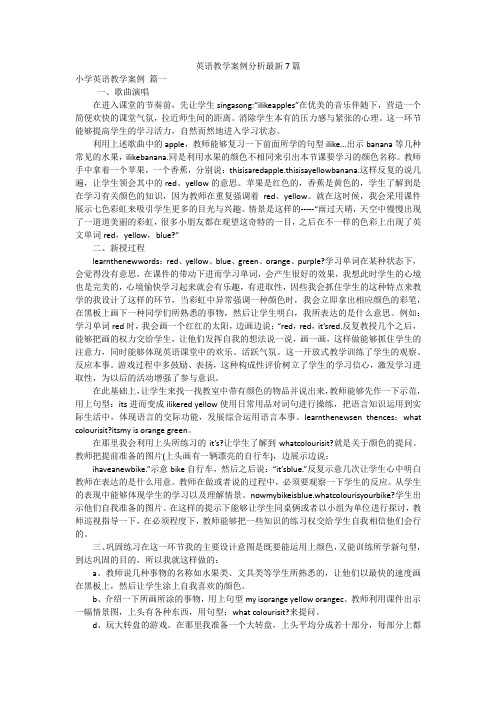
英语教学案例分析最新7篇小学英语教学案例篇一一、歌曲演唱在进入课堂的节奏前,先让学生singasong:“ilikeapples”在优美的音乐伴随下,营造一个简便欢快的课堂气氛,拉近师生间的距离。
消除学生本有的压力感与紧张的心理。
这一环节能够提高学生的学习活力,自然而然地进入学习状态。
利用上述歌曲中的apple,教师能够复习一下前面所学的句型ilike...出示banana等几种常见的水果,ilikebanana.同是利用水果的颜色不相同来引出本节课要学习的颜色名称。
教师手中拿着一个苹果,一个香蕉,分别说:thisisaredapple.thisisayellowbanana.这样反复的说几遍,让学生领会其中的red、yellow的意思。
苹果是红色的,香蕉是黄色的,学生了解到是在学习有关颜色的知识,因为教师在重复强调着red、yellow。
就在这时候,我会采用课件展示七色彩虹来吸引学生更多的目光与兴趣。
情景是这样的-----“雨过天晴,天空中慢慢出现了一道道美丽的彩虹,很多小朋友都在观望这奇特的一目,之后在不一样的色彩上出现了英文单词red,yellow,blue?”二、新授过程learnthenewwords:red、yellow、blue、green、orange、purple?学习单词在某种状态下,会觉得没有意思,在课件的带动下进而学习单词,会产生很好的效果,我想此时学生的心境也是完美的,心境愉快学习起来就会有乐趣,有进取性,因些我会抓住学生的这种特点来教学的我设计了这样的环节,当彩虹中异常强调一种颜色时,我会立即拿出相应颜色的彩笔,在黑板上画下一种同学们所熟悉的事物,然后让学生明白,我所表达的是什么意思。
例如:学习单词red时,我会画一个红红的太阳,边画边说:“red,red,it’sred.反复教授几个之后,能够把画的权力交给学生,让他们发挥自我的想法说一说,画一画,这样做能够抓住学生的注意力,同时能够体现英语课堂中的欢乐、活跃气氛。
英语教学案例5篇
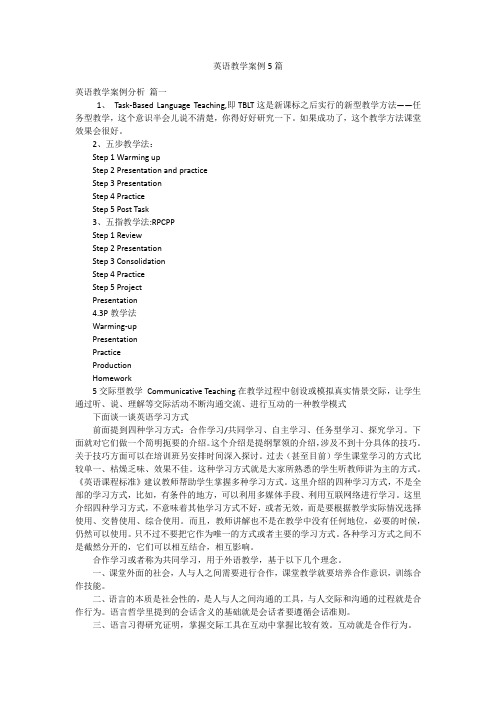
英语教学案例5篇英语教学案例分析篇一1、Task-Based Language Teaching,即TBLT这是新课标之后实行的新型教学方法——任务型教学,这个意识半会儿说不清楚,你得好好研究一下。
如果成功了,这个教学方法课堂效果会很好。
2、五步教学法:Step 1 Warming upStep 2 Presentation and practiceStep 3 PresentationStep 4 PracticeStep 5 Post Task3、五指教学法:RPCPPStep 1 ReviewStep 2 PresentationStep 3 ConsolidationStep 4 PracticeStep 5 ProjectPresentation4.3P教学法Warming-upPresentationPracticeProductionHomework5交际型教学Communicative Teaching在教学过程中创设或模拟真实情景交际,让学生通过听、说、理解等交际活动不断沟通交流、进行互动的一种教学模式下面谈一谈英语学习方式前面提到四种学习方式:合作学习/共同学习、自主学习、任务型学习、探究学习。
下面就对它们做一个简明扼要的介绍。
这个介绍是提纲挈领的介绍,涉及不到十分具体的技巧。
关于技巧方面可以在培训班另安排时间深入探讨。
过去(甚至目前)学生课堂学习的方式比较单一、枯燥乏味、效果不佳。
这种学习方式就是大家所熟悉的学生听教师讲为主的方式。
《英语课程标准》建议教师帮助学生掌握多种学习方式。
这里介绍的四种学习方式,不是全部的学习方式,比如,有条件的地方,可以利用多媒体手段、利用互联网络进行学习。
这里介绍四种学习方式,不意味着其他学习方式不好,或者无效,而是要根据教学实际情况选择使用、交替使用、综合使用。
而且,教师讲解也不是在教学中没有任何地位,必要的时候,仍然可以使用。
只不过不要把它作为唯一的方式或者主要的学习方式。
初中英语教学案例分析报告范文6篇
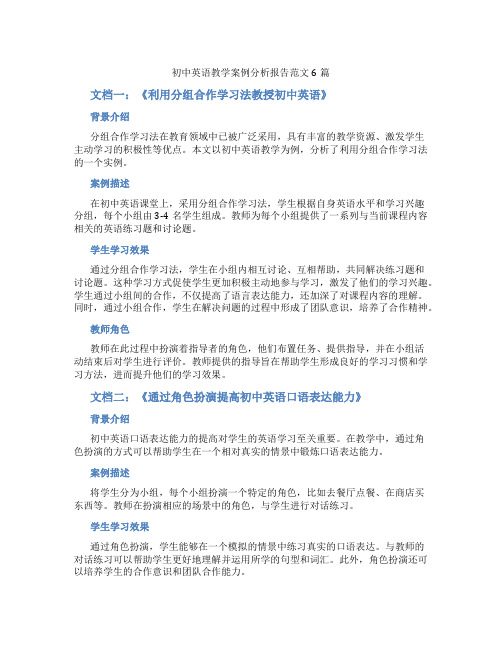
初中英语教学案例分析报告范文6篇文档一:《利用分组合作学习法教授初中英语》背景介绍分组合作学习法在教育领域中已被广泛采用,具有丰富的教学资源、激发学生主动学习的积极性等优点。
本文以初中英语教学为例,分析了利用分组合作学习法的一个实例。
案例描述在初中英语课堂上,采用分组合作学习法,学生根据自身英语水平和学习兴趣分组,每个小组由3-4名学生组成。
教师为每个小组提供了一系列与当前课程内容相关的英语练习题和讨论题。
学生学习效果通过分组合作学习法,学生在小组内相互讨论、互相帮助,共同解决练习题和讨论题。
这种学习方式促使学生更加积极主动地参与学习,激发了他们的学习兴趣。
学生通过小组间的合作,不仅提高了语言表达能力,还加深了对课程内容的理解。
同时,通过小组合作,学生在解决问题的过程中形成了团队意识,培养了合作精神。
教师角色教师在此过程中扮演着指导者的角色,他们布置任务、提供指导,并在小组活动结束后对学生进行评价。
教师提供的指导旨在帮助学生形成良好的学习习惯和学习方法,进而提升他们的学习效果。
文档二:《通过角色扮演提高初中英语口语表达能力》背景介绍初中英语口语表达能力的提高对学生的英语学习至关重要。
在教学中,通过角色扮演的方式可以帮助学生在一个相对真实的情景中锻炼口语表达能力。
案例描述将学生分为小组,每个小组扮演一个特定的角色,比如去餐厅点餐、在商店买东西等。
教师在扮演相应的场景中的角色,与学生进行对话练习。
学生学习效果通过角色扮演,学生能够在一个模拟的情景中练习真实的口语表达。
与教师的对话练习可以帮助学生更好地理解并运用所学的句型和词汇。
此外,角色扮演还可以培养学生的合作意识和团队合作能力。
教师在角色扮演中既是引导者,也是参与者。
他们需要起到积极引导学生参与角色扮演的作用,并及时给予学生反馈和指导。
教师还可以在角色扮演活动结束后进行整体的总结和评价。
文档三:《利用多媒体教具提高初中英语听力能力》背景介绍初中英语听力是学生英语学习中的重要环节。
小学英语案例分析
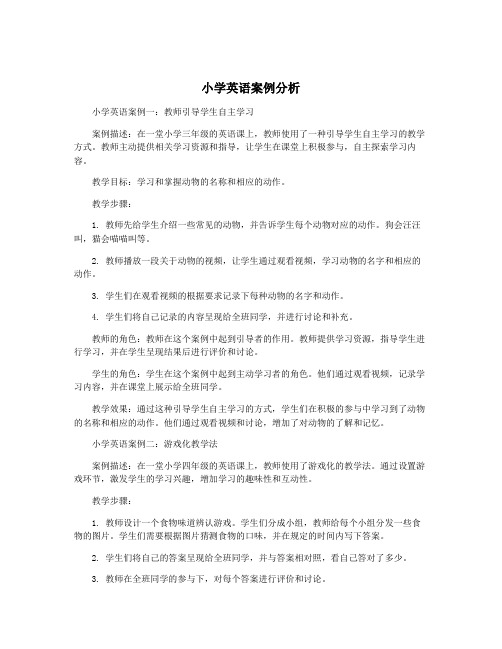
小学英语案例分析小学英语案例一:教师引导学生自主学习案例描述:在一堂小学三年级的英语课上,教师使用了一种引导学生自主学习的教学方式。
教师主动提供相关学习资源和指导,让学生在课堂上积极参与,自主探索学习内容。
教学目标:学习和掌握动物的名称和相应的动作。
教学步骤:1. 教师先给学生介绍一些常见的动物,并告诉学生每个动物对应的动作。
狗会汪汪叫,猫会喵喵叫等。
2. 教师播放一段关于动物的视频,让学生通过观看视频,学习动物的名字和相应的动作。
3. 学生们在观看视频的根据要求记录下每种动物的名字和动作。
4. 学生们将自己记录的内容呈现给全班同学,并进行讨论和补充。
教师的角色:教师在这个案例中起到引导者的作用。
教师提供学习资源,指导学生进行学习,并在学生呈现结果后进行评价和讨论。
学生的角色:学生在这个案例中起到主动学习者的角色。
他们通过观看视频,记录学习内容,并在课堂上展示给全班同学。
教学效果:通过这种引导学生自主学习的方式,学生们在积极的参与中学习到了动物的名称和相应的动作。
他们通过观看视频和讨论,增加了对动物的了解和记忆。
小学英语案例二:游戏化教学法案例描述:在一堂小学四年级的英语课上,教师使用了游戏化的教学法。
通过设置游戏环节,激发学生的学习兴趣,增加学习的趣味性和互动性。
教学步骤:1. 教师设计一个食物味道辨认游戏。
学生们分成小组,教师给每个小组分发一些食物的图片。
学生们需要根据图片猜测食物的口味,并在规定的时间内写下答案。
2. 学生们将自己的答案呈现给全班同学,并与答案相对照,看自己答对了多少。
3. 教师在全班同学的参与下,对每个答案进行评价和讨论。
学生的角色:学生在这个案例中起到游戏参与者的角色。
他们通过游戏参与到学习中,激发了学习的兴趣和积极性。
教学步骤:1. 教师向学生提出一个任务:假设你是一个商店的营业员,请你展示你的商店和向顾客介绍商品。
2. 学生们分成小组,每个小组扮演不同的角色,如营业员、顾客等。
英语教学案例分析(精选5则)
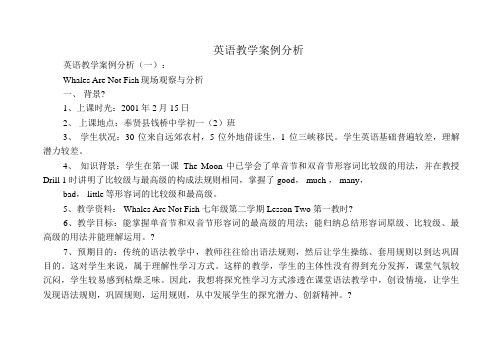
英语教学案例分析英语教学案例分析(一):Whales Are Not Fish现场观察与分析一、背景?1、上课时光:2001年2月15日2、上课地点:奉贤县钱桥中学初一(2)班3、学生状况:30位来自远郊农村,5位外地借读生,1位三峡移民。
学生英语基础普遍较差,理解潜力较差。
4、知识背景:学生在第一课The Moon 中已学会了单音节和双音节形容词比较级的用法,并在教授Drill 1 时讲明了比较级与最高级的构成法规则相同,掌握了good, much , many,bad, little等形容词的比较级和最高级。
5、教学资料: Whales Are Not Fish 七年级第二学期Lesson Two 第一教时?6、教学目标:能掌握单音节和双音节形容词的最高级的用法;能归纳总结形容词原级、比较级、最高级的用法并能理解运用。
?7、预期目的:传统的语法教学中,教师往往给出语法规则,然后让学生操练、套用规则以到达巩固目的。
这对学生来说,属于理解性学习方式。
这样的教学,学生的主体性没有得到充分发挥,课堂气氛较沉闷,学生较易感到枯燥乏味。
因此,我想将探究性学习方式渗透在课堂语法教学中,创设情境,让学生发现语法规则,巩固规则,运用规则,从中发展学生的探究潜力、创新精神。
?二、设计意图、教学片段及诊断分析“探究性学习”强调的是以学生为主体,问题为中心,研究为手段,实践为途径,过程体验重点,创新精神和实践潜力培养为目的的一种学习方式。
在本课设计时,我力求将上述特征体此刻课堂教学中。
我发现,研究性学习实施时三个相互交叉推进的阶段-进入问题情景、实践体验、表达和交流与外语教学“3P模式(Presentation -Practice-Production)”是相通的。
因此,我在Presentation这一阶段中,从身边的事物出发,创设情境,引出最高级,激发学生探求最高级使用规则的欲望并归纳总结(即发现、探究问题)。
在Practice这一阶段中,我让学生前后联系,构成形容词三种形式用法的知识网络,并探求相应的记忆策略,然后操练(即探究、实践问题)。
英语教学案例分析范文(精选27篇)
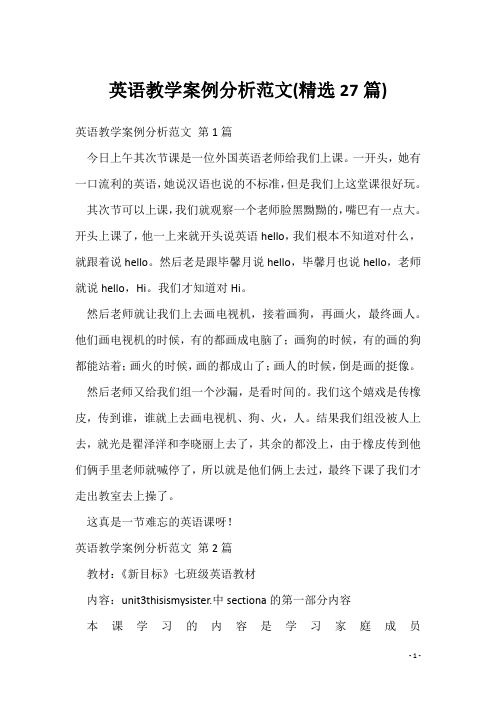
英语教学案例分析范文(精选27篇)英语教学案例分析范文第1篇今日上午其次节课是一位外国英语老师给我们上课。
一开头,她有一口流利的英语,她说汉语也说的不标准,但是我们上这堂课很好玩。
其次节可以上课,我们就观察一个老师脸黑黝黝的,嘴巴有一点大。
开头上课了,他一上来就开头说英语hello,我们根本不知道对什么,就跟着说hello。
然后老是跟毕馨月说hello,毕馨月也说hello,老师就说hello,Hi。
我们才知道对Hi。
然后老师就让我们上去画电视机,接着画狗,再画火,最终画人。
他们画电视机的时候,有的都画成电脑了;画狗的时候,有的画的狗都能站着;画火的时候,画的都成山了;画人的时候,倒是画的挺像。
然后老师又给我们组一个沙漏,是看时间的。
我们这个嬉戏是传橡皮,传到谁,谁就上去画电视机、狗、火,人。
结果我们组没被人上去,就光是翟泽洋和李晓丽上去了,其余的都没上,由于橡皮传到他们俩手里老师就喊停了,所以就是他们俩上去过,最终下课了我们才走出教室去上操了。
这真是一节难忘的英语课呀!英语教学案例分析范文第2篇教材:《新目标》七班级英语教材内容:unit3thisismysister.中sectiona的第一部分内容本课学习的内容是学习家庭成员(father,mother,parent,grandfather,grandmother,grandparent等)并学会向他人介绍自己的家庭成员(.),情境刺激-英语教学案例分析。
由于同学学校学习过家庭成员的英文单词,所以笔者把重点用于教同学如何介绍自己的家庭成员,这一部分也正是同学感爱好的话题。
英语教学案例分析范文第3篇一、前言:在实施新《课程标准》进展素养教育的今日,体育课堂教学不再是传统单调、枯燥的学习氛围,而是要通过教学让同学充分展现、体现自我。
充分体现一个中心、四个特点。
以让同学自动学习,乐观实践,努力创新为中心,结合体育学科突出四个特点。
特殊是对学校低班级同学来说,通过唱游形式进行体育教学,达到教学目的,提高学习成果,激发学习爱好,已逐步成为体育老师一种行之有效的教学**。
[专题范文]英语教学案例分析(精选5则)
![[专题范文]英语教学案例分析(精选5则)](https://img.taocdn.com/s3/m/2d777e2ede80d4d8d15a4f51.png)
[专题范文]英语教学案例分析(精选5则)英语教学案例分析英语教学案例分析(一):whalesAreNotFish现场观察与分析一、背景?1、上课时光:2001年2月15日2、上课地点:奉贤县钱桥中学初一(2)班3、学生状况:30位来自远郊农村,5位外地借读生,1位三峡移民。
学生英语基础普遍较差,理解潜力较差。
4、知识背景:学生在第一课Themoon中已学会了单音节和双音节形容词比较级的用法,并在教授Drill1时讲明了比较级与最高级的构成法规则相同,掌握了good,much,many,bad,little等形容词的比较级和最高级。
5、教学资料:whalesAreNotFish七年级第二学期LessonTwo第一教时?6、教学目标:能掌握单音节和双音节形容词的最高级的用法;能归纳总结形容词原级、比较级、最高级的用法并能理解运用。
?7、预期目的:传统的语法教学中,教师往往给出语法规则,然后让学生操练、套用规则以到达巩固目的。
这对学生来说,属于理解性学习方式。
这样的教学,学生的主体性没有得到充分发挥,课堂气氛较沉闷,学生较易感到枯燥乏味。
因此,我想将探究性学习方式渗透在课堂语法教学中,创设情境,让学生发现语法规则,巩固规则,运用规则,从中发展学生的探究潜力、创新精神。
?二、设计意图、教学片段及诊断分析“探究性学习”强调的是以学生为主体,问题为中心,研究为手段,实践为途径,过程体验重点,创新精神和实践潜力培养为目的的一种学习方式。
在本课设计时,我力求将上述特征体此刻课堂教学中。
我发现,研究性学习实施时三个相互交叉推进的阶段-进入问题情景、实践体验、表达和交流与外语教学“3P模式(Presentation-Practice-Production)”是相通的。
因此,我在Presentation这一阶段中,从身边的事物出发,创设情境,引出最高级,激发学生探求最高级使用规则的欲望并归纳总结(即发现、探究问题)。
九年级英语教学案例分析范文6篇

九年级英语教学案例分析范文6篇Teaching English to Grade 9 students can be a challenging yet rewarding experience. At this stage, students are transitioning from middle school to high school and are expected to develop more advanced language skills. As an English teacher, it is crucial to design and implement effective lesson plans that cater to the diverse needs and learning styles of Grade 9 students. In this essay, we will explore six sample English teaching case studies for Grade 9 that can serve as a valuable reference for educators.Case Study 1: Improving Reading ComprehensionIn this case study, the focus is on enhancing the reading comprehension skills of Grade 9 students. Many students at this level struggle with understanding complex literary texts, such as novels, short stories, and poetry. The teacher recognized this challenge and decided to implement a structured approach to improve their reading skills.The lesson plan began with an introduction to the selected text, where the teacher provided background information and context tohelp students better understand the content. Next, the teacher utilized various strategies to engage students in active reading, such as asking guiding questions, encouraging them to make predictions, and highlighting key literary devices.During the reading process, the teacher encouraged students to take notes, annotate the text, and engage in discussions with their peers. This collaborative approach allowed students to share their interpretations, ask questions, and gain a deeper understanding of the text.To further reinforce the reading comprehension skills, the teacher assigned follow-up activities, such as written summaries, literary analysis essays, and oral presentations. These assignments not only assessed the students' understanding but also provided opportunities for them to develop their critical thinking and communication skills.The results of this case study were promising, as the students demonstrated significant improvements in their ability to comprehend and analyze literary texts. The teacher's use of a structured approach, active reading strategies, and diverse assessment methods contributed to the students' overall growth in reading comprehension.Case Study 2: Developing Effective Writing SkillsIn this case study, the focus is on helping Grade 9 students develop their writing skills. Many students at this level struggle with organizing their thoughts, expressing their ideas clearly, and adhering to the conventions of academic writing.The teacher began by introducing the writing process, emphasizing the importance of prewriting, drafting, revising, and editing. Students were guided through various prewriting activities, such as brainstorming, outlining, and researching, to help them generate and organize their ideas.During the drafting stage, the teacher provided explicit instruction on the elements of effective writing, including thesis statements, topic sentences, supporting details, and transitions. Students were encouraged to experiment with different writing styles and structures, depending on the assigned task (e.g., persuasive essay, narrative, research paper).To promote peer learning and feedback, the teacher incorporated peer-review sessions, where students exchanged their drafts and provided constructive criticism to one another. This process allowed students to receive valuable feedback and refine their writing before the final submission.The teacher also emphasized the importance of revision and editing, guiding students through the process of improving their work based on the feedback received. Students were taught to identify and correct common writing errors, such as grammar, punctuation, and spelling mistakes.The results of this case study were positive, as the students demonstrated significant improvements in their writing skills. They were able to organize their thoughts more effectively, express their ideas more clearly, and adhere to the conventions of academic writing. The structured approach to the writing process, combined with targeted feedback and revision opportunities, contributed to the students' overall growth as writers.Case Study 3: Enhancing Oral Communication SkillsIn this case study, the focus is on developing the oral communication skills of Grade 9 students. Many students at this level struggle with public speaking, expressing their thoughts clearly, and engaging in meaningful discussions.The teacher recognized the importance of oral communication skills in academic and professional settings and decided to incorporate various activities and strategies to help students improve in this area.The lesson plan began with an introduction to the principles ofeffective public speaking, such as body language, eye contact, and vocal variety. Students were given opportunities to practice these skills through short presentations, debates, and group discussions.To build confidence and reduce anxiety, the teacher encouraged a supportive and collaborative classroom environment. Students were encouraged to provide constructive feedback to their peers and to actively participate in discussions.The teacher also incorporated role-playing activities, where students were assigned different personas or scenarios to practice their communication skills. This approach allowed students to experiment with different communication styles and receive feedback on their performance.To further enhance their oral communication skills, the teacher assigned project-based learning activities that required students to work in teams and present their findings to the class. This not only developed their presentation skills but also their ability to collaborate and communicate effectively with their peers.The results of this case study were encouraging, as the students demonstrated significant improvements in their oral communication skills. They became more confident in public speaking, more adept at expressing their thoughts clearly, and more engaged in classdiscussions. The structured approach to developing these skills, combined with opportunities for practice and feedback, contributed to the students' overall growth in this area.Case Study 4: Integrating Technology in the ClassroomIn this case study, the focus is on integrating technology in the Grade 9 English classroom to enhance the learning experience. Many students at this level are digital natives and are comfortable with various technological tools, so the teacher decided to leverage this familiarity to engage students and improve their learning outcomes.The lesson plan incorporated the use of multimedia resources, such as educational videos, interactive presentations, and online learning platforms. The teacher carefully selected these resources to align with the curriculum and to provide students with engaging and informative content.To encourage active learning, the teacher incorporated technology-based activities, such as online quizzes, collaborative document editing, and virtual discussions. These activities allowed students to interact with the content, apply their knowledge, and receive immediate feedback.The teacher also encouraged students to use technology for research, writing, and presentation purposes. Students were given theopportunity to use online databases, word processing software, and presentation tools to complete their assignments and projects.To ensure the effective integration of technology, the teacher provided clear instructions and guidance on the use of these tools. Students were also encouraged to share their knowledge and experiences with their peers, fostering a collaborative learning environment.The results of this case study were positive, as the students demonstrated increased engagement, motivation, and learning outcomes. The integration of technology not only made the learning process more interactive and enjoyable but also helped students develop essential digital literacy skills.Case Study 5: Differentiated Instruction for Diverse LearnersIn this case study, the focus is on implementing differentiated instruction to address the diverse learning needs of Grade 9 students. In any given classroom, there is a wide range of learning styles, abilities, and backgrounds, and the teacher recognized the importance of adapting the instruction to cater to these differences.The lesson plan incorporated various instructional strategies and materials to accommodate the diverse learners in the classroom. This included providing different levels of text complexity, offeringalternative assignment options, and utilizing a variety of teaching methods (e.g., direct instruction, group work, independent learning).The teacher also incorporated formative assessments throughout the lessons to gauge the students' understanding and to identify areas where they needed additional support. Based on this information, the teacher provided targeted interventions and scaffolding to help students overcome their challenges.To promote inclusivity and support, the teacher fostered a collaborative learning environment where students were encouraged to work together, share their strengths, and support one another. This approach not only helped struggling students but also challenged the high-achieving students to take on more complex tasks and to mentor their peers.The results of this case study were positive, as the students demonstrated improved learning outcomes and increased engagement in the classroom. The differentiated instruction approach allowed the teacher to meet the diverse needs of the students, resulting in a more inclusive and effective learning environment.Case Study 6: Fostering Cross-Cultural UnderstandingIn this case study, the focus is on fostering cross-culturalunderstanding in the Grade 9 English classroom. As students navigate the transition to high school, it is important to help them develop a deeper appreciation for diversity and a global perspective.The teacher recognized the importance of exposing students to different cultures, perspectives, and experiences through the study of literature, media, and current events. The lesson plan incorporated the use of diverse texts, such as short stories, poems, and articles, that represented a range of cultural backgrounds and experiences.The teacher facilitated discussions and activities that encouraged students to compare and contrast the cultural elements present in the texts, to reflect on their own cultural identities, and to engage in respectful dialogue with their peers.To further enhance cross-cultural understanding, the teacher invited guest speakers, organized field trips to cultural events, and encouraged students to participate in cultural exchange programs. These experiences allowed students to directly engage with diverse perspectives and to develop a more nuanced understanding of the world around them.The teacher also incorporated project-based learning activities that required students to research and present on different cultures, traditions, and global issues. This approach not only deepened theirknowledge but also developed their critical thinking and communication skills.The results of this case study were positive, as the students demonstrated increased cultural awareness, empathy, and respect for diversity. They were able to engage in meaningful discussions, challenge their own biases, and develop a more global perspective. The integration of diverse texts, cultural experiences, and project-based learning contributed to the students' overall growth in cross-cultural understanding.In conclusion, these six sample English teaching case studies for Grade 9 provide valuable insights into the effective strategies and approaches that can be implemented in the classroom. By addressing the diverse needs of students, incorporating technology, fostering cross-cultural understanding, and promoting active learning, teachers can create a dynamic and engaging learning environment that supports the academic and personal growth of Grade 9 students.。
关于英语教学案例简析教学案例分析100例
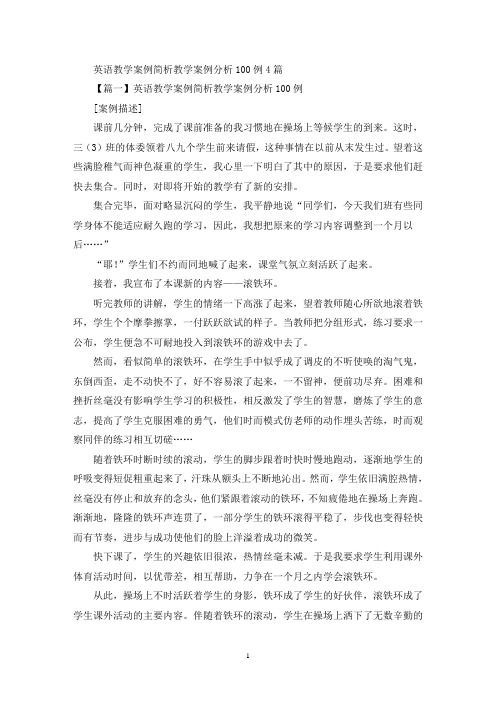
英语教学案例简析教学案例分析100例4篇【篇一】英语教学案例简析教学案例分析100例[案例描述]课前几分钟,完成了课前准备的我习惯地在操场上等候学生的到来。
这时,三(3)班的体委领着八九个学生前来请假,这种事情在以前从末发生过。
望着这些满脸稚气而神色凝重的学生,我心里一下明白了其中的原因,于是要求他们赶快去集合。
同时,对即将开始的教学有了新的安排。
集合完毕,面对略显沉闷的学生,我平静地说“同学们,今天我们班有些同学身体不能适应耐久跑的学习,因此,我想把原来的学习内容调整到一个月以后……”“耶!”学生们不约而同地喊了起来,课堂气氛立刻活跃了起来。
接着,我宣布了本课新的内容——滚铁环。
听完教师的讲解,学生的情绪一下高涨了起来,望着教师随心所欲地滚着铁环,学生个个摩拳擦掌,一付跃跃欲试的样子。
当教师把分组形式,练习要求一公布,学生便急不可耐地投入到滚铁环的游戏中去了。
然而,看似简单的滚铁环,在学生手中似乎成了调皮的不听使唤的淘气鬼,东倒西歪,走不动快不了,好不容易滚了起来,一不留神,便前功尽弃。
困难和挫折丝毫没有影响学生学习的积极性,相反激发了学生的智慧,磨炼了学生的意志,提高了学生克服困难的勇气,他们时而模式仿老师的动作埋头苦练,时而观察同伴的练习相互切磋……随着铁环时断时续的滚动,学生的脚步跟着时快时慢地跑动,逐渐地学生的呼吸变得短促粗重起来了,汗珠从额头上不断地沁出。
然而,学生依旧满腔热情,丝毫没有停止和放弃的念头,他们紧跟着滚动的铁环,不知疲倦地在操场上奔跑。
渐渐地,隆隆的铁环声连贯了,一部分学生的铁环滚得平稳了,步伐也变得轻快而有节奏,进步与成功使他们的脸上洋溢着成功的微笑。
快下课了,学生的兴趣依旧很浓,热情丝毫未减。
于是我要求学生利用课外体育活动时间,以优带差,相互帮助,力争在一个月之内学会滚铁环。
从此,操场上不时活跃着学生的身影,铁环成了学生的好伙伴,滚铁环成了学生课外活动的主要内容。
伴随着铁环的滚动,学生在操场上洒下了无数辛勤的汗珠,滚铁环的技术也越来越纯熟,方法也变得丰富多彩。
英语教学案例分析优秀6篇
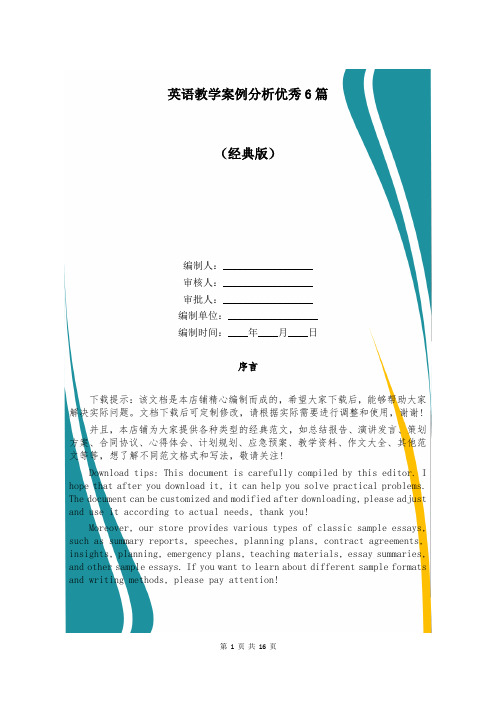
英语教学案例分析优秀6篇(经典版)编制人:__________________审核人:__________________审批人:__________________编制单位:__________________编制时间:____年____月____日序言下载提示:该文档是本店铺精心编制而成的,希望大家下载后,能够帮助大家解决实际问题。
文档下载后可定制修改,请根据实际需要进行调整和使用,谢谢!并且,本店铺为大家提供各种类型的经典范文,如总结报告、演讲发言、策划方案、合同协议、心得体会、计划规划、应急预案、教学资料、作文大全、其他范文等等,想了解不同范文格式和写法,敬请关注!Download tips: This document is carefully compiled by this editor. I hope that after you download it, it can help you solve practical problems. The document can be customized and modified after downloading, please adjust and use it according to actual needs, thank you!Moreover, our store provides various types of classic sample essays, such as summary reports, speeches, planning plans, contract agreements, insights, planning, emergency plans, teaching materials, essay summaries, and other sample essays. If you want to learn about different sample formats and writing methods, please pay attention!英语教学案例分析优秀6篇教学设计是运用系统方法,发现教育问题,结合学习理论和教学理论,解决问题(提出计划,试行计划),作出评价,并不断的进行完善的过程。
- 1、下载文档前请自行甄别文档内容的完整性,平台不提供额外的编辑、内容补充、找答案等附加服务。
- 2、"仅部分预览"的文档,不可在线预览部分如存在完整性等问题,可反馈申请退款(可完整预览的文档不适用该条件!)。
- 3、如文档侵犯您的权益,请联系客服反馈,我们会尽快为您处理(人工客服工作时间:9:00-18:30)。
英语教学案例分析
如果教好初中英语课堂教学,我们只有认真地反思我们的教育教学现状和我们的教学实践,才能不断地发现问题、分析问题、解决问题。
因此,科学的、有效的教学反思可以减少遗憾。
所以,好的教法是开展好教学活动的基本保证,在教学活动中善于总结,善于应用,才能不断地推进教学活动的开展。
教师要明确教学任务,熟悉教学内容,能够做到承上启下,准确授课。
不仅备教材,还要备学生,为准确制定目标奠定基础。
该“会运用”,就要能当堂运用,不能人为地降低或提高要求。
让学生在上课时就明确学习目标,使其学习有方向,激发其学习动机,调动其学习积极性,从而促进学生在以后各个环节里主动地围绕目标探索、追求。
案例片段(一)思考的问题:在单词教学中如何变单一为多样,变死板为生动?我在教授单词的过程中十分注重单词的使用语境,如在教授cook和cooker这两个单词的时候,我分别出示了几张图片(一些橱具和两位橱师),让学生通过对图片的直观感知,从第一印象开始就对他们有一个清晰而明确的认识,从而避免了对这两个词汇的混淆。
然后再通过
“He is a good cook,he has a lot of cookers.”这样的例句加深学生对他们的理解和运用。
教学反思:新目标(人教版)的教材词汇量大,单词长,生僻词较多,自然也就增加了教学的难度,但我们又必须让学生掌握,否则难以适应教材的要求。
那么我们该采取什么方式来教学单词呢?美国学者埃克斯雷指出:“能够引起学生学习兴趣的方法就是最好的方法。
”实践证明,拼图法,数字游戏,单词接龙游戏,小歌诀,顺口溜等传统教学方法并不过时,教师再辅以现代化的教学手段,借助图片,课件。
动漫等手段,真正达到重情景,重趣味.重运用,使单词具有语言的意义,使其在特定的语境中被引出,这样既便于学生理解,印象也深刻,从而达到学以致用的效果。
在英语教学中适时地加入这些美味的“作料”,无疑是一种优化组合的创新,它不但能极大地激发学生的学习兴趣,更能提高学生的学习积极性。
案例片段(二)思考的问题:如何把英语对话教学引入到生活中,达到学以致用?中国学生的英语学习现状是往往学习了几年。
甚至是十几年的英语,还不能开口说英语,而只能纸上谈兵。
我在教学中十分注重学生对对话的理解和运用,但在实际的操作中效果并不理想。
如我
在教授:
Sandra:Hi,Gina!
Gina:Hi,Sandra!How’s it going?
Sandra:I。
m in France.Ifm calling to see how you are.
Gina:Oh。
thanks!
Sandra:How’it going?
Gina:Pretty good!I'm just doing my homework.How
are you?
Sandra:Great!I'm with my pen pal.She’s from Paris.
We ale having lunch.
Gina:Cool!How’s the weather there?
Sandra:Great!Hot and sunny.How‘s the weather in
Shanghai?
Gina:Also hot.And really humid.
这个对话,在第二天提问时。
学生的背诵情况很好,但当我要求他们重新组织一个对话时,效果不尽人意。
要么两人一组的搭配不合适,按照固定的座位进行操练,有的搭配过于悬殊。
开展不了对话;要么只会运用近期的知识点,稍微久远的就遗忘。
1.问题之源起
学生迸行一个单元的知识整理作业。
之前的预习虽然也给了除了要求,但是考虑到学生是初学者,学习能力还不够强,对整理作业的要求不高。
整理时只要他们整理出新学的单词、词组、旬捌和语法知识即可,并没有对整理到什么程度作出细致的要求。
机缘巧合,同事由于接班。
对其班级的整理作业进行了新的要求,非常详细,具体到名词要分出可数不可数,形容词要给出比较级、最高级,动词要给出其第三人称单数、进行时、过去式等.考虑到这个单元刚好学习形容词的比较级和最高级形式,而且之前已经对这个知识点有了初步的学习.我决定也从这个单元开始对他们的事理进行细致的系统的要求。
因此,一次系统的整理
作业出炉了。
但就是这次作业却让我得到了意想不到的收获,让我对初中英语教学又有了新的认识。
真正体验到了“教学相长”的涵义。
问题出现在第二天的作业批改中。
在我进行批改之前。
同事张老师已经开始批改,她碰到了疑问,就问我:“honest的比较级是加-er呢还是用more呢?opposite呢?”我快速的思考了一下。
然后在电脑上进行查询,很快确定了honest 的比较级是用more+opposite等部分形容词没有比较级。
但是因为自己在做别的事情,就没有进行进一步思考:哪些形容词没有比较级,为什么没有。
发现几乎所有的学生在形容词这个部分把本单元的形容词整理进去以后,非常想当然的写下了
“opposite—more opposite—the most opposite”.我开始认真考虑这个问题,并希望能够给出一个系统的确切的解答。
